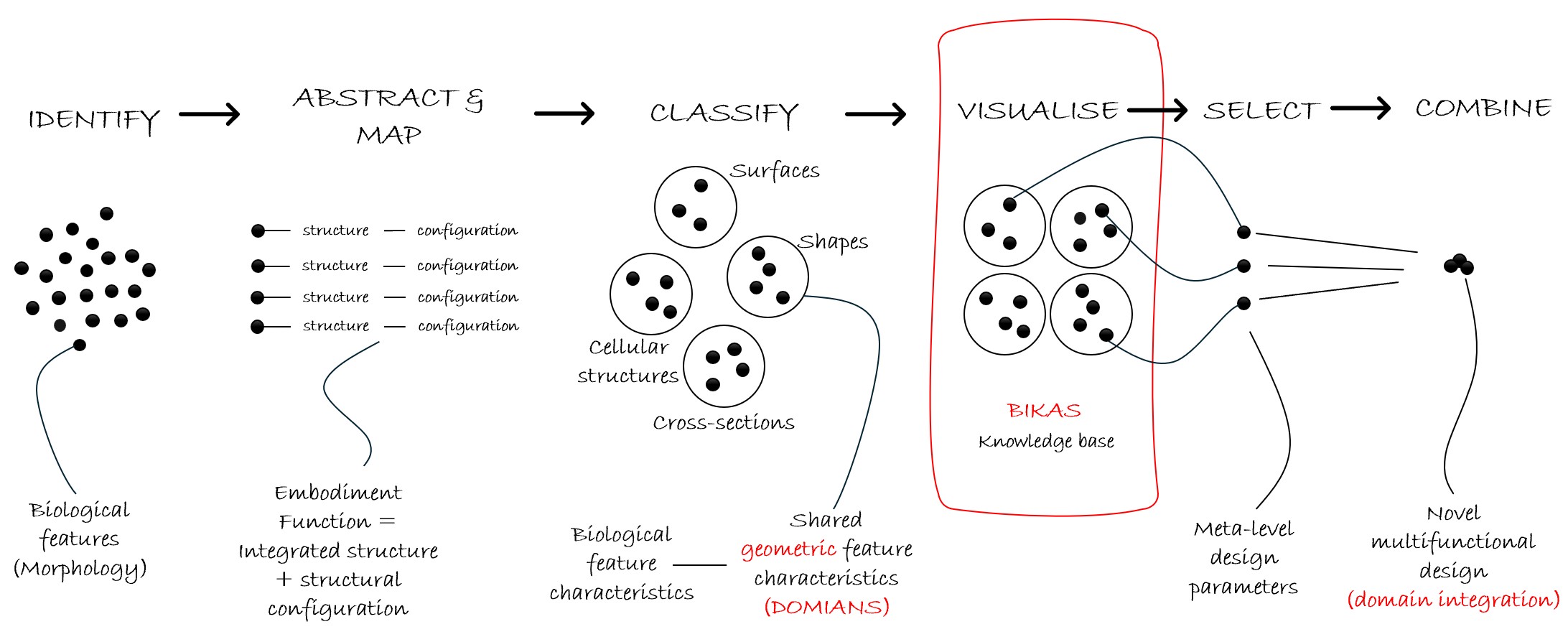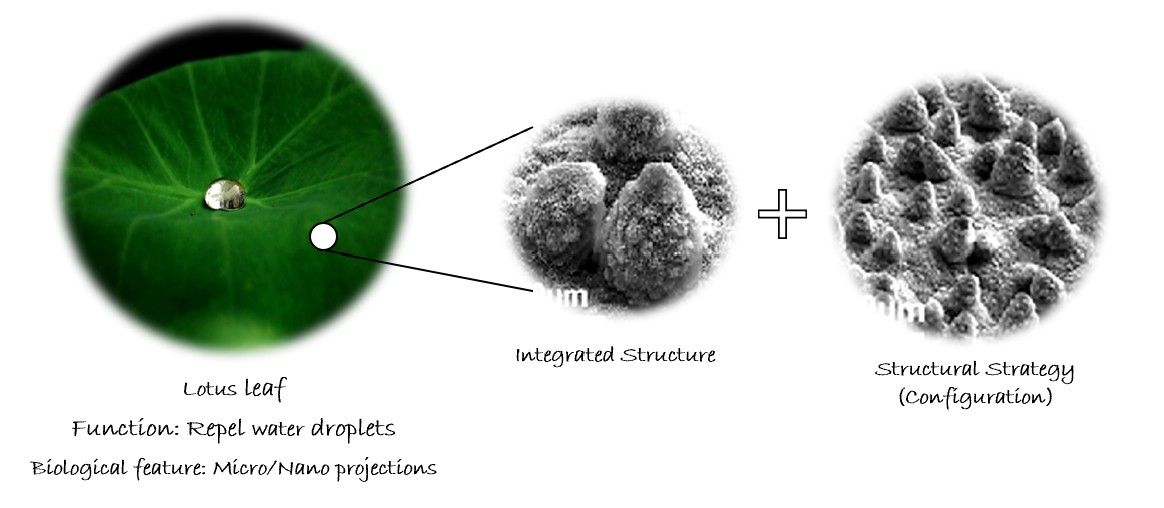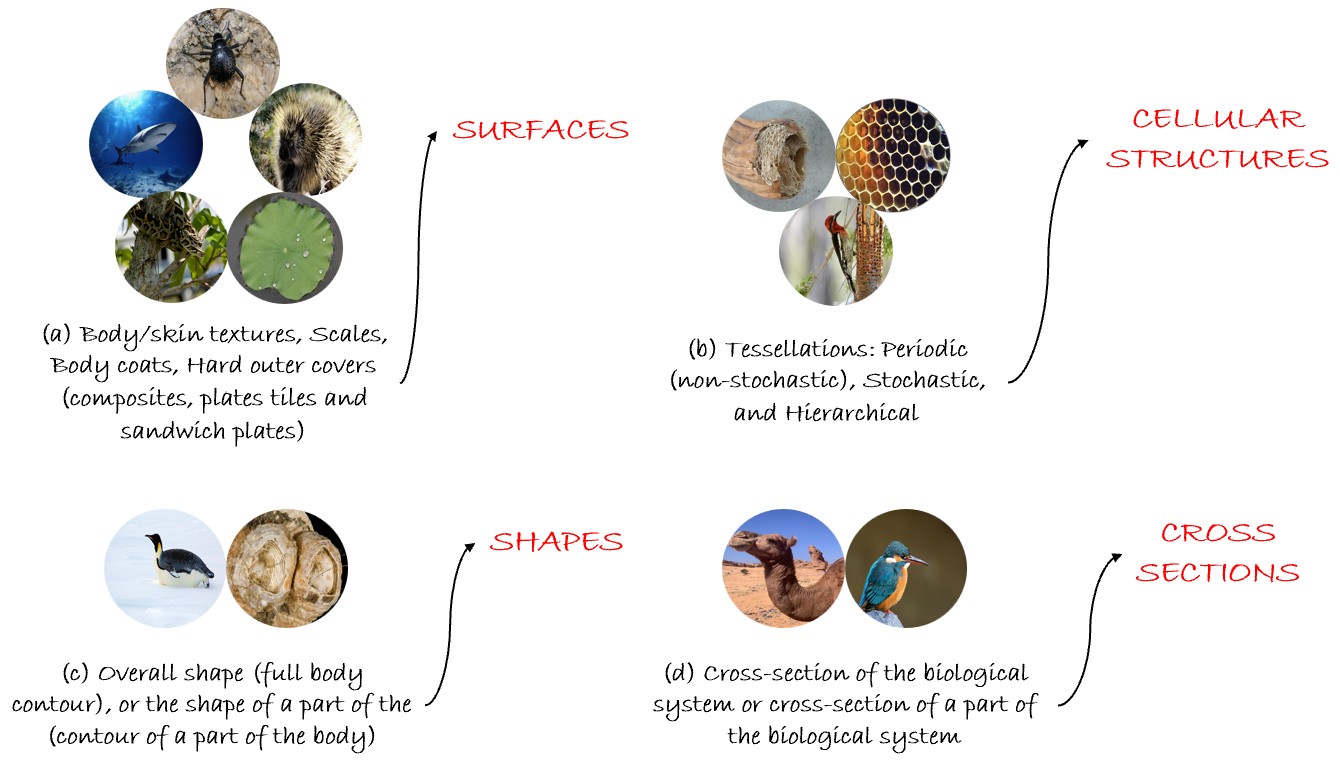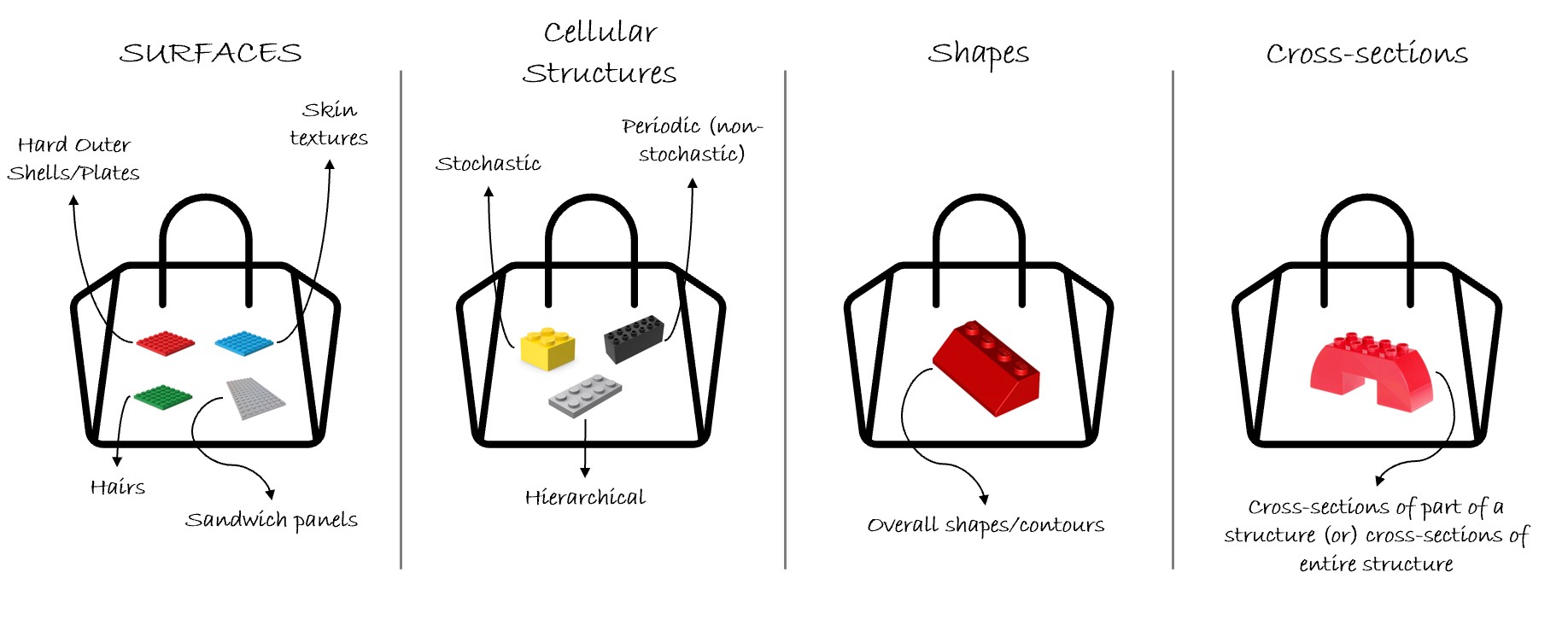IDEATION SYSTEM
The MBID Ideation System is built upon several key components. Figure 4 is an illustration
describing the key components starting from identification, abstraction & mapping, function-structrue relationship, classification, visualisation, selection and combination.
 Fig 4: Illustration of the key components of the ideation system
Fig 4: Illustration of the key components of the ideation system
IDENTIFY
Identifying the organisms exhibiting various functions through their
morphological features by drawing information from published articles and case studies in scientific literature.
ABSTRACT & MAP
Each biological (morphological) feature is meticulously mapped to its corresponding function and the tissue (material) from which it originates.
Furthermore, the embodiment function achieved by a feature is understood as a blend of its integrated structure and its structural strategy (configuration).
Function-Structure Realtionship
The embodiment function is a synergistic outcome of an integrated structure and its structural strategy.
Figure 5 is a schematic illustrating the embodiment function of a lotus leaf in repelling water.
This function results from a combination of micro/nano projections (integrated structure)
on the leaf's surface and the arrangement of these micro/nano structures (structural strategy).
 Fig 5: Lotus leaf's repel water (superhydrophobocity) is a result of the combination of
its integrated micro/nano surface structures and the stratergy (configuration/arrangement) of the micro/nano structures.
(Pictures of biological organisms from wikimedia commons)
Fig 5: Lotus leaf's repel water (superhydrophobocity) is a result of the combination of
its integrated micro/nano surface structures and the stratergy (configuration/arrangement) of the micro/nano structures.
(Pictures of biological organisms from wikimedia commons)
Integrated structure refers to the physical description of a multiscale structure.
This includes details like micro/nanostructure, macrostructure, and even the presence of features like wax layers.
Structural strategy defines the integrated structural configuration. This encompasses aspects such as the arrangement, packing,
or orientation of micro/nanostructures, symmetry, asymmetry, or tessellation patterns. It also accounts for
changes in structural configuration due to external stimuli,
such as the erection of scales or a change in skin compliance, which occur when other elements interact with the structure.
Table 1 is an example of the lotus leaf's morphology contributing to its exhibited repel water function.
Table 1: Embodiment function as a combination of integrated structure and structural stratergy
| Biological Feature |
Embodiment Function |
Integrated Structure |
Structrual Configuraiton |
| Micro/Nano projections (Lotus leaf). |
Repel Water Droplets. |
Microstructures with a wax layer and pointed in shape. |
Arrangement: The random arrangement of micro perturbances. |
CLASSIFY
The biological (morphological) features are identified, abstracted, mapped,
and classified based on their shared geometric characteristics, referred to in this research as Domains.
These Domains represent overarching structural designations that guide the classification process and include: Surfaces, Cellular Structures,
Cross-sections, and Shapes
The Figure 6 illustrates a classification system for biological features, categorizing them into distinct domains based on their primary geometric characteristic or designation.
 Fig 6: The classification of biological features by their shared or a common geometric characteristic or designation (domains).
(Pictures of biological organisms from wikimedia commons)
Fig 6: The classification of biological features by their shared or a common geometric characteristic or designation (domains).
(Pictures of biological organisms from wikimedia commons)
The list of Domains is expandable, and additional categories may be introduced as the system evolves.
The Table 2 is an example of the abstraction & mapping and classification of the Lotus leaf's morphology.
Table 2: Abstraction and mapping of the lotus leaf's morphology to its embodiment function,
including integrated structure, structural strategy, feature characteristics,
tissue/material, and the domain to which it belongs.
| Biological Feature |
Embodiment Function |
Integrated Structure |
Structrual Stratergy |
Biological feature characteristic |
Tissue/Material |
Domain |
| Micro/Nano projections (Lotus leaf). |
Repel Water Droplets. |
Microstructures with a wax layer and pointed in shape. |
Arrangement: The random arrangement of micro perturbances. |
Body/Skin texture (Plants) |
Epidermal tissue (Micro-papillae and epicuticular wax) |
Surfaces |
VISUALISE
The MBID ideation system currently abstracts, maps, and classifies approximately 60 biological features based on shared geometric characteristics,
referred to as domains. This growing knowledge base, known as BIKSAS (Bio-Inspired Knowledge Acquisition and Simulacrum), is continuously expanding.
To support intuitive exploration, tree dendrograms are used to visualize these features, enabling users to select and combine them to generate multifunctional design concepts.
SELECT
In nature, multiple features might share similar geometric characteristics and perform similar functions.
For instance, both shark and dolphin skin contribute to drag reduction. To choose among such alternatives (e.g., shark skin vs. dolphin skin for drag reduction),
we apply meta-level design parameters and specific design criteria.The Table 3 presents quantitative parameters developed for
selecting features that exhibit similar functions and share comparable geometric characteristics or domains.
Criterion 1: For multifunctional applications where one function involves anti-adsorption,
absorption, repulsion, or reduction, select features with a lower total interaction area for combination.
Criterion 2: For multifunctional applications where one function involves adsorption,
absorption, or attraction, select features with a higher interaction area for combination.
Qualitative parameters
Users can also incorporate additional qualitative criteria into their selections, such as the environmental context where the design will be applied.
For instance, when designing a device for arid regions, users could choose to include biological adaptations specific to those environments
Table 3: Meta-level design parameters for selection for each domain
| Domain |
Meta-level design parameters |
| Surfaces |
Interaction area |
| Cellular Structures |
Interction area and Porosity |
| Shapes |
Scale |
| Cross-sections |
Scale |
Note: These meta-level design parameters are just a starting point; we'll add more as the system evolves.
COMBINE
The morphology matrix is used to combine different morphological features systematically.
Morphology & Multifunctionality
Some morphological features are inherently multifunctional.
For example, animal exoskeletons must simultaneously fulfill various roles like providing fracture toughness,
regulating temperature, and offering camouflage.
While these functions can coexist and even compete, MBID systematically combines multiple morphological features.
This allows us to create novel engineering structures with function combinations that extend beyond merely coexisting or competing functions.







